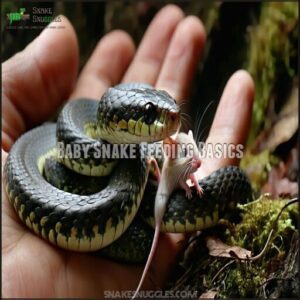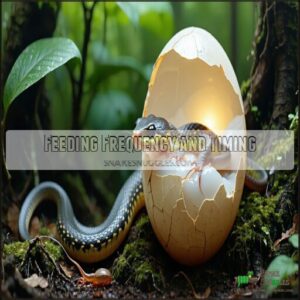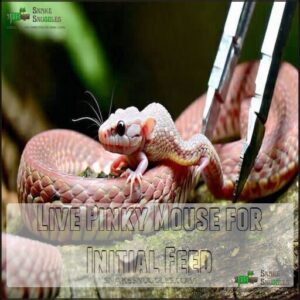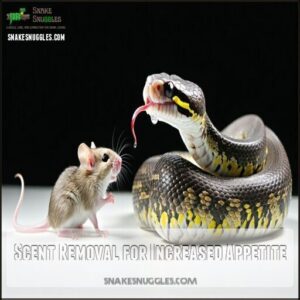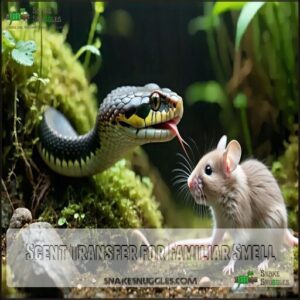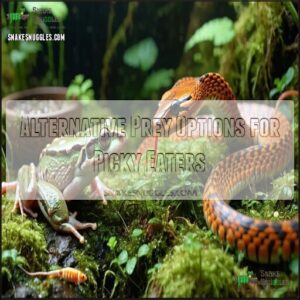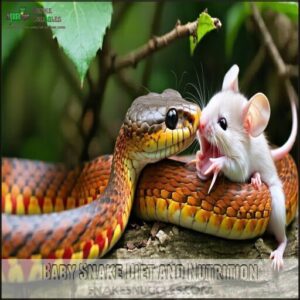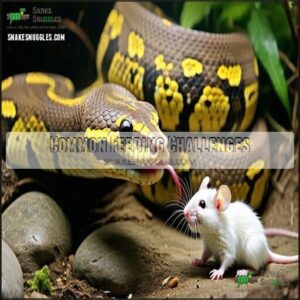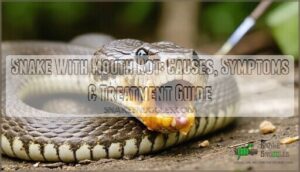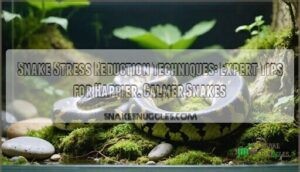This site is supported by our readers. We may earn a commission, at no cost to you, if you purchase through links.
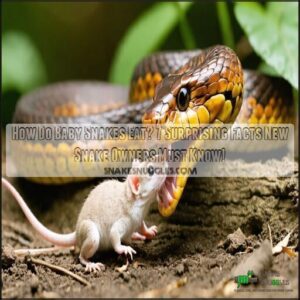 Baby snakes eat by swallowing their prey whole, thanks to their stretchy jaws and powerful muscles. They usually start with tiny prey, like pinky mice or small insects, depending on their species.
Baby snakes eat by swallowing their prey whole, thanks to their stretchy jaws and powerful muscles. They usually start with tiny prey, like pinky mice or small insects, depending on their species.
After hatching, some baby snakes don’t eat right away because they still absorb nutrients from their yolk sacs.
Once they’re hungry, they hunt by sensing heat and movement. You’ll need to offer appropriately sized prey; anything too large can scare or stress them.
Baby snakes depend on instinct to eat, so don’t worry if they need a little time. Curious about picky eaters or special techniques? Stay tuned!
Table Of Contents
- Baby Snake Feeding Basics
- How Baby Snakes Eat
- Feeding Frequency and Timing
- Encouraging Baby Snakes to Eat
- Baby Snake Diet and Nutrition
- Common Feeding Challenges
- Frequently Asked Questions (FAQs)
- How does a snake feed its babies?
- How long does it take for a baby snake to eat?
- How to make baby snakes eat?
- How do small snakes eat?
- What do small baby snakes eat?
- How do female snakes feed their babies?
- How do you keep a baby snake alive?
- What do baby snakes eat in the wild?
- How long can baby snakes go without food?
- Can baby snakes bite?
- Conclusion
Baby Snake Feeding Basics
You’ll need to create the right feeding environment for your baby snake by keeping it warm, dry, and in a small container with proper hiding spots.
Baby snakes typically start eating within a month after hatching, so offer appropriately sized prey like pinky mice that match the snake’s girth.
Warm and Dry Environment
Creating a temperature-controlled habitat is essential for baby snake feeding success.
Your newborn snake’s enclosure needs consistent warmth (75-85°F depending on species) with proper humidity control to aid digestion. A suitable snake heat mat can help achieve this.
Choose the right substrate that retains heat without becoming too damp. This warm, dry environment mimics their natural habitat and keeps their metabolism functioning efficiently, ensuring young snakes eat regularly and digest prey efficiently.
Small Container for Reduced Stress
For the sake of reduced stress, keep your baby snake in a small container while feeding. This creates a secure feeling and increases the chances of successful prey encounters.
Using a separate feeding container reduces stress and prevents bites.
- Small deli cups work perfectly for most hatchlings
- Clear containers help you monitor feeding progress
- Containers should have airholes but not too many
- A tight-fitting lid prevents escapes during feeding
- Remove the snake after feeding to its regular habitat
Separate Hatchlings for Easy Feeding
Cluttermates don’t make good mealtime companions for baby snakes.
You’ll need to separate hatchlings to prevent feeding shyness and reduce competition.
Providing suitable baby snake enclosures is essential for their health and well-being.
Each little serpent requires individualized diets and easier monitoring of food intake.
Keeping hatchlings in separate containers minimizes stress while offering feeding baby snakes the ideal environment to thrive.
You’ll also avoid aggression issues that often arise when multiple newborn snakes share living quarters during mealtimes.
Providing Shelter for Security
Hidden within their enclosure, baby snakes need secure shelters to feel safe enough to eat.
You’ll find they’re more likely to feed when they’ve proper hiding spots that reduce stress.
- Use small hide boxes placed at both warm and cool ends
- Try paper towel rolls, cork bark, or commercial reptile hides
- Position shelters away from bright light and high-traffic areas
- Choose snug-fitting shelters where they can touch walls for security
How Baby Snakes Eat
Many baby snakes eat differently than their adult counterparts. While all snakes swallow prey whole, hatchlings require special considerations due to their size and inexperience.
- Baby snakes focus on prey size that matches their body girth (typically 1-1.5 times their thickness)
- Their flexible jaws expand remarkably to consume relatively large meals
- Hatchlings use the same constriction or venom hunting techniques as adults, just on smaller prey
- Most baby snakes possess an egg tooth that falls off shortly after birth
- Young snakes rely heavily on scenting techniques to locate appropriate food
Unlike mammals, baby snakes don’t need parental guidance to eat. They’re born with instinctive hunting abilities, though captive-bred snakes may need some encouragement.
Their diet varies by species – some strictly eat rodents while others prefer insects, amphibians, or eggs. Understanding what do baby snakes eat is essential for proper care of your new pet.
Feeding Frequency and Timing
You’ll need to feed your baby snake within a month of hatching, once it’s shed its first skin.
Your snake’s yolk reserves will sustain it initially, but you should start offering appropriate-sized prey regularly to support its rapid growth.
Waiting for First Shed
You’ll need to wait for your baby snake’s first shed before offering food. This vital milestone typically occurs 1-2 weeks after hatching and signals their readiness to eat.
Snakes undergo a complex shedding cycle for growth and health. During this shed cycle duration, their digestive system finalizes development.
Watch for recognizing shedding signs like cloudy eyes and dull skin. Post-shed feeding is essential, as newborn snakes are most receptive to meals after completing this first important physiological process.
Newborn snakes are most receptive to meals after completing this first important physiological process.
Offering Live Pinky Mice
After that first shed, your baby snake is ready for its first meal.
Offer live pinky mice as your hatchling’s initial food source. Live prey stimulates a feeding response through movement, making it irresistible to your hungry snake.
Here’s why live pinkies work well:
- Their movement triggers your snake’s hunting instinct
- Newborn mice are small enough for hatchlings to swallow
- Their soft bodies are easy to digest
- Their warmth attracts baby snakes
- They provide complete nutrition for growing snakes
Monitoring Hatchling’s Activity and Appetite
Once your hatchling is settled with live pinky mice, pay close attention to its appetite cues.
You’ll need to observe behavior regularly to confirm proper feeding.
Weight monitoring is critical for hatchling snakes, as it helps establish patterns in your newborn snake feeding guide.
Record each feeding to track the snake’s growth and development, and to identify any potential health issues.
This information will be essential in ensuring the proper care of your hatchling.
Considering Yolk Reserves and Environmental Temperature
Your baby snake’s yolk reserves are nature’s first meal ticket, lasting approximately 1-2 weeks after hatching.
Temperature regulation directly impacts their metabolic rate and digestion efficiency.
Keep enclosures at ideal temperatures (75-85°F for most species) to facilitate proper feeding timing.
Cooler environments slow a snake’s metabolism, while warmer settings increase hunger.
This balance is vital for baby snake survival during their shift to active hunting.
Temperature regulation directly impacts their metabolic rate and digestion efficiency.
Encouraging Baby Snakes to Eat
You’ll need to use specific techniques to encourage reluctant baby snakes to eat their first meals.
Reluctant baby snakes often need gentle techniques like scenting prey or offering live pinky mice to spark their feeding instinct.
Keep their container small so they easily find their food.
Try scenting prey with familiar smells like lizards or frogs if they refuse to eat.
Live Pinky Mouse for Initial Feed
Live pinky mice are often the go-to first meal for your baby snake. These tiny, hairless newborn mice match the natural prey size that hatchlings can handle.
New snake owners can purchase live pinky mice online.
When offering live prey, use feeding tongs to prevent accidental bites. Many snake species instinctively respond to movement, making live pinkies more enticing than frozen ones for that vital first feeding experience.
Scent Removal for Increased Appetite
Odor sensitivity can make baby snakes reject prey items.
To increase your hatchling’s appetite, wash prey items thoroughly to remove any handling scents.
Human odor can deter small snakes from eating. Minimize human scent by rinsing pinky mice in warm water before offering them.
This simple step can dramatically improve feeding success for reluctant eaters, especially when switching them to their new baby snake diet.
Note: I’ve bolded the phrase "reluctant eaters" as it is a key phrase that helps a reader skim the text and understand the target audience of the advice.
Scent Transfer for Familiar Smell
When washing doesn’t work, try scent transfer techniques to entice your reluctant baby snake to eat.
Rub prey items against lizards, frogs, or use commercial scents that mimic natural prey.
Here’s how to transfer scent effectively:
- Rub a pinky mouse against a lizard to transfer its scent
- Use frog scent for species that naturally eat amphibians
- Try commercial rodent scents available at reptile shops
This method triggers your snake’s hunting instincts by making prey smell familiar, which can encourage your snake to eat.
Alternative Prey Options for Picky Eaters
When scenting doesn’t work, it’s time to try different menu options.
For picky eaters, small lizards or frog legs often tempt reluctant feeders. Fish pieces work well for water-loving species, while some keepers report success with mealworms for certain small snakes.
Commercial baby snake food scents can also help. Remember, what young snakes eat in captivity should mimic their natural diet.
Baby Snake Diet and Nutrition
You’ll need to feed your baby snake prey that’s no bigger than 1-1.5 times its body width, as all snake species have specific dietary needs.
Baby snakes eat smaller versions of adult food like pinky mice, tiny insects, or small amphibians depending on their species.
Prey Size and Type
Now that you’ve learned ways to encourage eating, let’s talk about selecting the right food.
Prey size must match your baby snake’s body – never exceed 1-1.5 times their thickness. Baby snakes hunt animals smaller than themselves in the wild.
When feeding, remember that suitable prey varies by species. Most baby snakes can handle pinky mice, but some might need smaller options.
Proper prey size guarantees easier digestion and reduces stress. It’s also essential to provide a balanced diet, as snakes are natural carnivores that thrive on a diet rich in protein.
Insects and Small Animals as Food
After choosing the right-sized prey, you’ll need to understand what baby snakes actually eat.
Young snakes consume different foods based on their species. While some babies exclusively hunt rodent prey, others prefer insects or small amphibians.
In the wild, baby snakes might eat tiny lizards, frogs, or even invertebrates.
When captive, most snake keepers start with pinky mice, which provide complete nutrition for growing snakes.
Rapid Growth and Maturity
Baby snakes grow at a remarkable pace after hatching. You’ll notice your snake’s size changes rapidly, with many species doubling in length during their first year.
Baby snakes grow quickly, often doubling in size during their first year with proper feeding and care.
This growth rate requires frequent feeding to fuel their development. Newborn snakes often rely on yolk sac nutrition for initial sustenance.
Most snakes reach sexual maturity within two to three years, when their dietary shifts may occur. Proper nutrition during this early stage is essential for healthy development and eventual reproductive onset.
Species-Specific Dietary Needs
As your snake matures, its rapid growth requires specific nutrition based on species.
Your corn snake won’t thrive on the same diet as your ball python. Different species have unique digestive systems and metabolic rates that determine their prey type and size requirements.
Understanding a snake species’ diet is essential for their health.
What do young snakes eat? Garter snakes might prefer amphibians, while baby brown snakes need smaller rodents.
Small snakes’ diets must match their specific nutritional needs for proper development, which is crucial for their overall well-being.
Common Feeding Challenges
You’ll face several obstacles when feeding your baby snake, including stress-related food refusal or temperature issues that suppress appetite.
Problems with feeding should be addressed quickly, as baby snakes need proper nutrition for healthy growth and may require techniques like scent transfer or professional advice in stubborn cases.
Snake Anorexia Causes
During the first few weeks of life, your baby snake won’t eat for various reasons.
Stress from moving, handling, or environmental disruptions often triggers snake anorexia. Temperature issues substantially impact appetite, as does shedding.
Illness, parasites, or kidney failure represent more serious concerns. Other factors include lack of privacy, noise, breeding season, or pregnancy.
Understanding these causes helps you address problems before considering more drastic measures.
Force Feeding as a Last Resort
Force feeding snakes should always be a last resort since it’s a stressful procedure that can cause potential harm.
If a baby snake won’t eat despite efforts, consult a vet before attempting syringe feeding.
Force feeding hatchlings improperly risks injury or regurgitation due to stress.
Always prioritize safety and make certain your baby snake’s diet aligns with its natural needs.
- Stress increases feeding difficulties.
- Improper feeding risks choking or harm.
- Vet guidance improves success rates.
Risks and Stress of Force Feeding
Force feeding snakes can trigger stress hormones, causing regurgitation and anorexia. It’s risky too—injury potential includes internal damage or aspiration.
Infection risk rises if improper tools are used. On a psychological level, the snake may associate feeding with stress.
Only attempt this as a last resort, as it can harm rather than help.
Seeking Professional Advice for Guidance
If your pet snake won’t eat, it’s time to reach out for professional advice.
Reptile veterinarians, herpetological societies, or experienced breeders can guide you on raising baby snakes and what to feed newborn reptiles. A thorough snake feeding guide offers further support.
Online forums and wildlife rehabilitators also offer helpful insights. Baby snake care questions often need expert input, especially with tricky feeding challenges.
Note: I have bolded the phrase "Baby snake care" as it is a key phrase that helps a reader skim the text and understand the main topic.
Frequently Asked Questions (FAQs)
How does a snake feed its babies?
You might imagine baby snakes needing parental care, but they’re born completely independent.
Snakes don’t feed their young; hatchlings survive on internal yolk reserves and start hunting small prey, like insects or mice, on their own.
How long does it take for a baby snake to eat?
Baby snakes typically take up to a month after hatching to start eating.
They use stored yolk reserves initially.
Offering small, manageable prey like pinky mice or lizards encourages feeding as their appetite develops.
How to make baby snakes eat?
Good things come to those who wait—but snakes prefer patience paired with strategy.
Warm their enclosure, offer tiny prey like pinky mice, scent the food with lizard or frog smells, and verify they’ve shed first.
How do small snakes eat?
Small snakes swallow their prey whole, using strong jaw muscles and stretchy ligaments to move food down.
They prioritize prey smaller in girth than themselves, ensuring digestion.
Hiding reduces stress and encourages natural eating behavior.
Note: I’ve bolded the phrase "natural eating behavior" as it seems to be a key concept in the text. If you’d like me to bold a different phrase, please let me know!
What do small baby snakes eat?
Imagine a tiny predator equipped with instincts ready to hunt.
Baby snakes eat small, soft prey like insects, newborn rodents, or amphibians.
Make certain prey matches their size, and keep the environment warm to encourage feeding.
How do female snakes feed their babies?
Female snakes don’t feed their babies.
Once they’re born or hatched, baby snakes are on their own to hunt. They rely on instincts to catch small prey like insects, lizards, or rodents that they can swallow whole.
How do you keep a baby snake alive?
Keeping a baby snake alive is like nurturing a delicate plant.
Provide proper warmth, a secure enclosure, fresh water, and small prey.
Make certain the environment suits its species, and avoid unnecessary handling while monitoring its health.
What do baby snakes eat in the wild?
In the wild, baby snakes eat tiny prey like insects, small amphibians, or lizards, depending on their species.
They hunt by using their instincts to strike, grab, and swallow prey whole, no chewing involved!
How long can baby snakes go without food?
A baby snake hatched with yolk reserves can survive weeks without food.
They use this energy until their first feeding, usually after shedding.
However, ensuring they eat soon helps avoid health issues or slowed growth.
Can baby snakes bite?
Yes, baby snakes can bite.
Even though they’re small, their bites can still hurt and, in venomous species, deliver venom.
Always handle them carefully and avoid provoking them to prevent bites.
Conclusion
Feeding baby snakes can feel like solving a puzzle, but with the right steps, it’s manageable.
Understanding how baby snakes eat—using their stretchy jaws and instincts to swallow whole prey—helps provide proper care.
Start with small, suitable prey like pinky mice and maintain a calm environment to reduce stress.
Monitor their appetite and activity, and don’t rush; some hatchlings rely on yolk reserves early on.
Patience and observation are key to raising a healthy, thriving snake.

